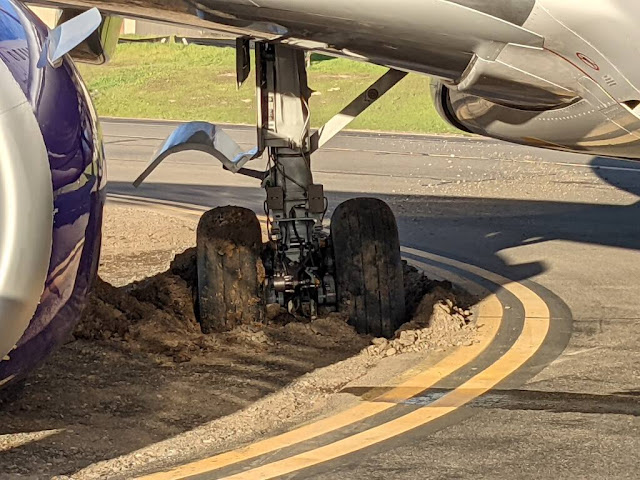Avelo Airlines
A plane set to take off from the Charles M. Schulz-Sonoma County Airport on Sunday went off the pavement on the way to a runway, prompting the evacuation of passengers on board, officials said.
There were 109 passengers and six staff members on the Avelo Airlines flight headed for the Hollywood Burbank airport in Los Angeles County, according to an airline spokeswoman.
Nobody on the plane was injured in the incident, which happened at about 3 p.m., said Jon Stout, manager of the airport northwest of Santa Rosa.
The pilot was turning from a taxiway to a runway and cut a corner too tight, Stout said.
Two of the plane’s wheels were driven into the dirt and got stuck, Stout said.
The plane, a Boeing 737-800, was towed out of the dirt by aircraft tugs, which followed the airport’s protocol for such incidents, according to Stout.
Passengers got off the plane and were taken back to the airport terminal on two Sonoma County Airport Express buses.
“We are working with our customers to accommodate them on alternative flights to (the Hollywood Burbank airport) this evening and tomorrow morning,” Avelo spokeswoman Courtney Goff said Sunday in an email.
Goff said the airline is investigating what caused the incident.




















There is a reason taxiways have that yellow center stripe, and they are most crucial in tight turns where there is soft soil off the taxiway. One would think the captain, the only pilot up front with a tiller, would be very mindful of this knowing the 738 engines are just 18-24 inches above the surface depending on weight.
ReplyDeleteDoes this come out of his paycheck?
DeleteIt most certainly does but indirectly. The captain's next review and raise potential will have this on his record.
DeleteYeah, weirdly enough 737 pilots cannot see their wings (which co-locates the landing gear) from the cockpit, so they are continually ESTIMATING from experience how much turn is required on any particular taxiway. It’s why there is a MASSIVE amount of empty space, clearance, and paved area at major airports.
DeleteIt’s this geometry and physical layout that saves most airline pilots from major grief. Those that operate at smaller fields practice and get used to smaller turn radius’ over time, but incidents can and do occur.
Also weirdly enough, when you’re turning 130 feet of aircraft, the yellow centerline on a narrow tight radius taxiway may have no relation to the actual nose wheel placement and degrees of turn.
Not excusing this pilot, he may have just screwed up - but your GA armcharing doesn’t apply.
Looks like narrow taxiway to me. And the building visible in the background makes it likely this is a turn from taxiway A to A6 while preparing to enter runway 32. That's a 90 degree turn. So while your 104.3 hours in a Cirrus SR-22 may make you THINK that this wouldn't have happened to you if you followed the yellow stripe, you'd in FACT be quite wrong.
ReplyDeleteA trick I was taught when checking out in the left seat of large transport category aircraft, is to keep the stripe "under the inside epaulets" as you look in the direction of the turn....in other words, you gotta overshoot the yellow stripe with the nose wheel, cuz the mains are WAY behind you and ya can't see em. The larger the turn, the more ya gotta overshoot in order to keep the mains on the pavement. But the epaulet technique works.
...even more important if the taxiway is narrow.
Wow! I knew this would happen sooner than later ... Learn from this Sir!
ReplyDeleteA 737 NG attempting to navigate a 90 degree turn will require the nose wheel to travel about 10 to 12 feet beyond the center line of the taxiway that it is attempting to join if you wish the main gear to stay centered on the taxiways at all times. The above shoulder method works "OK" if you are moving around on major airports. But for smaller fields and narrower taxiways, you need to oversteer to the outer limits of the hard surface to guarantee you wont depart the taxiway with the mains. Remember that the nose tire sits about 14' behind the nose of the aircraft.
ReplyDeleteIf we now have small camera lenses on autos to use with screen monitor to view hidden areas backing up, then certainly , Boeing should be able to add this feature to assist pilots in turning with blind spots.
ReplyDelete